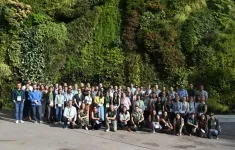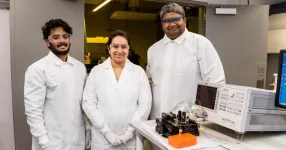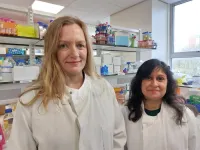(Press-News.org) CAMBRIDGE, MA -- The genome of the SARS-CoV-2 virus encodes 29 proteins, one of which is an ion channel called E. This channel, which transports protons and calcium ions, induces infected cells to launch an inflammatory response that damages tissues and contributes to the symptoms of Covid-19.
MIT chemists have now discovered the structure of the “open” state of this channel, which allows ions to flow through. This structure, combined with the “closed” state structure that was reported by the same lab in 2020, could help scientists figure out what triggers the channel to open and close. These structures could also guide researchers in developing antiviral drugs that block the channel and help prevent inflammation.
“The E channel is an antiviral drug target. If you can stop the channel from sending calcium into the cytoplasm, then you have a way to reduce the cytotoxic effects of the virus,” says Mei Hong, an MIT professor of chemistry and the senior author of the study.
MIT postdoc Joao Medeiros-Silva is the lead author of the study, which appears today in Science Advances. MIT postdocs Aurelio Dregni and Pu Duan and graduate student Noah Somberg are also authors of the paper.
Open and closed
Hong has extensive experience in studying the structures of proteins that are embedded in cell membranes, so when the Covid-19 pandemic began in 2020, she turned her attention to the coronavirus E channel.
When SARS-CoV-2 infects cells, the E channel embeds itself inside the membrane that surrounds a cellular organelle called the ER-Golgi intermediate compartment (ERGIC). The ERGIC interior has a high concentration of protons and calcium ions, which the E channel transports out of ERGIC and into the cell cytoplasm. That influx of protons and calcium leads to the formation of multiprotein complexes called inflammasomes, which induce inflammation.
To study membrane-embedded proteins such as ion channels, Hong has developed techniques that use nuclear magnetic resonance (NMR) spectroscopy to reveal the atomic-level structures of those proteins. In previous work, her lab used these techniques to discover the structure of an influenza protein known as the M2 proton channel, which, like the coronavirus E protein, consists of a bundle of several helical proteins.
Early in the pandemic, Hong’s lab used NMR to analyze the structure of the coronavirus E channel at neutral pH. The resulting structure, reported in 2020, consisted of five helices tightly bundled together in what appeared to be the closed state of the channel.
“By 2020, we had matured all the NMR technologies to solve the structure of this kind of alpha-helical bundles in the membrane, so we were able to solve the closed E structure in about six months,” Hong says.
Once they established the closed structure, the researchers set out to determine the structure of the open state of the channel. To induce the channel to take the open conformation, the researchers exposed it to a more acidic environment, along with higher calcium ion levels. They found that under these conditions, the top opening of the channel (the part that would extend into the ERGIC) became wider and coated with water molecules. That coating of water makes the channel more inviting for ions to enter.
That pore opening also contains amino acids with hydrophilic side chains that dangle from the channel and help to attract positively charged ions.
The researchers also found that while the closed channel has a very narrow opening at the top and a broader opening at the bottom, the open state is the opposite: broader at the top and narrower at the bottom. The opening at the bottom also contains hydrophilic amino acids that help draw ions through a narrow “hydrophobic gate” in the middle of the channel, allowing the ions to eventually exit into the cytoplasm.
Near the hydrophobic gate, the researchers also discovered a tight “belt,” which consists of three copies of phenylalanine, an amino acid with an aromatic side chain. Depending on how these phenylalanines are arranged, the side chains can either extend into the channel to block it or swing open to allow ions to pass through.
“We think the side chain conformation of these three regularly spaced phenylalanine residues plays an important role in regulating the closed and open state,” Hong says.
Viral targeting
Previous research has shown that when SARS-CoV-2 viruses are mutated so that they don’t produce the E channel, the viruses generate much less inflammation and cause less damage to host cells.
Working with collaborators at the University of California at San Francisco, Hong is now developing molecules that could bind to the E channel and prevent ions from traveling through it, in hopes of generating antiviral drugs that would reduce the inflammation produced by SARS-CoV-2.
Her lab is also planning to investigate how mutations in subsequent variants of SARS-CoV-2 might affect the structure and function of the E channel. In the Omicron variant, one of the hydrophilic, or polar, amino acids found in the pore opening is mutated to a hydrophobic amino acid called isoleucine.
“The E variant in Omicron is something we want to study next,” Hong says. “We can make a mutant and see how disruption of that polar network changes the structural and dynamical aspect of this protein.”
###
The research was funded by the National Institutes of Health and the MIT School of Science Sloan Fund.
END
Targeting a coronavirus ion channel could yield new Covid-19 drugs
Chemists discover the structures of open and closed states of the channel, which could help the development of antiviral drugs to reduce inflammation
2023-10-13
ELSE PRESS RELEASES FROM THIS DATE:
Kentucky Children's Hospital to expand specialized services at new facility in Lexington
2023-10-13
LEXINGTON, Ky. (Oct. 11, 2023) — On Tuesday, Oct. 10, a ribbon-cutting ceremony signified the official opening of Kentucky Children’s Richmond Road, the new home of four pediatric specialty clinics. This facility will offer a continuum of care to infants, children and adolescents with complex medical and behavioral needs.
“The mission of Kentucky Children’s Hospital has always been to provide the most advanced, comprehensive care to our patients and their families without them having to travel far from home,” said Scottie B. Day, M.D., physician-in-chief ...
Advancing solutions: SELINA gathers members and stakeholders for the second thematic workshop
2023-10-13
The second SELINA thematic workshop took place from 2-5 October 2023 in Madrid, Spain, hosted by SELINA’s partner Rey Juan Carlos University. This hybrid event with the theme "Advancing solutions" (for mapping, assessment and accounting of ecosystems and their services) brought together over 100 participants (15 of them online) from all 27 EU member states, Israel, Norway, the UK and Switzerland. Apart from the SELINA partners, the event was also attended by the SELINA Advisory Board members ...
University of Kentucky awarded $3.4 million to lead equity initiative in drug abuse research
2023-10-13
LEXINGTON, Ky. (Oct. 11, 2023) — The University of Kentucky has been selected as the nationwide coordination center for a National Institutes of Health (NIH) initiative. Danelle Stevens-Watkins, Ph.D., will lead the National Institute on Drug Abuse (NIDA) Racial Equity Initiative as principal investigator. The project is supported by a $3.4 million, five-year NIDA grant.
The UK Racial Equity Initiative Coordinating Center will be a national resource for researchers receiving funding to address health disparities ...
Three Johns Hopkins Medicine faculty members elected to National Academy of Medicine
2023-10-13
Three faculty members at the Johns Hopkins University School of Medicine have been elected to the National Academy of Medicine (NAM), an independent organization made up of leading professionals from multiple fields, such as public health, medicine, and natural, social and behavioral sciences. NAM serves alongside the National Academy of Sciences and the National Academy of Engineering as advisors to the national and international science communities.
The announcement of 100 new members was made October 9.
New members elected to NAM are chosen by current ...
Cancer researchers awarded $4.6 million to advance liquid biopsy test for early lung cancer detection
2023-10-13
A team of investigators from the UCLA Jonsson Comprehensive Cancer Center and the UCLA School of Dentistry received a five-year $4.6 million grant from the National Cancer Institute to develop and improve liquid biopsy technologies for the early detection of lung cancer — the leading cause of cancer death in both men and women in the U.S.
UCLA is one of five institutions in the nation that is part of the NCI Liquid Biopsy Consortium that is designed to find a better way to detect early signs of lung cancer in people with ...
NJIT awarded $6 million from the National Science Foundation to commercialize campus inventions
2023-10-13
NJIT has secured a $6 million grant from the National Science Foundation (NSF) to translate science and engineering discoveries into market-ready technologies that will improve quality of life in areas ranging from health care, to sustainable energy, to data privacy.
Awarded by the agency’s Directorate for Technology, Innovation, and Partnerships, the grant will accelerate the development of promising prototypes and enable market validation and other commercialization activities. It will also strengthen the university’s entrepreneurial culture ...
Fecal microbe transplants: B. vulgatus genes that correlate with early colonization
2023-10-13
BIRMINGHAM, Ala. – Fecal microbe transplants from healthy donors can treat patients with recurrent Clostridium difficile infections. However, after tens of thousands transplants, little was known about which donor strains provide long-term engraftment, and which engraft early after the transplant. Most failures of fecal microbe transplantation occur in the first four weeks.
Recurrent C. difficile infections occur after suppressive antibiotic treatments that knock out almost all of the normal gut flora. Patients suffer watery diarrhea, painful abdominal cramps, a feeling of sickness, fevers and weight loss.
In 2021, researchers at the Icahn ...
Funding will help further development of bacteriophages to combat disease on a commercial scale
2023-10-13
Pioneering work to develop effective and safe bacteriophages to combat disease has received an £800,000 boost.
The grant from the Biotechnology and Biological Sciences Research Council (BBSRC), is aimed at advancing the production of phages to combat disease in the veterinary field and bring them to market.
It has been awarded to Professor Martha Clokie, the Director of the Leicester Centre of Phage Research, and Dr Anisha Thanki who earlier this year successfully developed a bacteriophage ‘liquid’ product to prevent Salmonella ...
How weather phenomena affect ocean circulation
2023-10-13
The strength of the wind has an important influence on ocean circulation. This is particularly true for extreme events such as storm fronts, tropical storms and cyclones. These weather patterns, which last from a few days to a few weeks, will change in the future due to climate change. In particular, the average energy input into the ocean from mid-latitude storms is expected to decrease, while equatorial regions will become more active. Scientists call these different weather patterns “Atmospheric Synoptic Variability” (ASV).
The ...
Behind the scenes of social class on TV
2023-10-13
A Leeds researcher has teamed up with the BBC, Channel 4 and Candour Productions to analyse the role of social class, on screen and behind the scenes of TV production.
Funded by the Arts and Humanities Research Council (AHRC), the BBC and Channel 4 will work with the research team to support access to two drama productions, where the academics will analyse the series from production to reception.
Led by Beth Johnson, Professor of Television and Media Studies at the University of Leeds’ School of Media and Communication, the research will consider the backgrounds of people who produce TV, how social class is represented in each TV show, and how each series is ...
LAST 30 PRESS RELEASES:
Discovery reveals how keto diet can prevent seizures when drugs fail
JMIR Publications and Sikt announce pilot flat-fee unlimited open access partnership
Finding new cell markers to track the most aggressive breast cancer in blood
A new, cleaner way to make this common fertilizer
Fire-safe all-solid-state batteries move closer to commercialization
Disinfecting drinking water produces potentially toxic byproducts — new AI model is helping to identify them
Unplanned cesarean deliveries linked to higher risk of acute psychological stress after childbirth
Healthy aging 2026: fresh pork in plant-forward diets supported strength and brain-health biomarkers in older adults
Scientists identify pre-cancerous states in seemingly normal aging tissues
Itaconate modifications: mechanisms and applications
Potential tumor-suppressing gene identified in pancreatic cancer
Winners of the 2026 Hill Prizes announced
Autonomous AI agents developed to detect early signs of cognitive decline
Study finds ocean impacts nearly double economic cost of climate change
Increased deciduous tree dominance reduces wildfire carbon losses in boreal forests
Researchers discover how a respiratory bacterium obtains essential lipids from the human body and targets fat-rich tissues
Locust swarms destroy crops. Scientists found a way to stop that
More resources and collaboration needed to support prevention and treatment of obesity
Two types of underconfidence linked to anxiety and gender
Insects are victims too: Global study shows impacts of invasive alien species on populations
Pioneering natural, degradable polymer capsules
Forestry is becoming digital and automated
Maternity baby deaths much higher in northern England than in the South
Mosquitoes’ thirst for human blood has increased as biodiversity loss worsens
The stop-smoking medication varenicline may also work for cannabis use disorder
Potential new treatment for sepsis
Study reveals how many hours of video games per week might be too many
Electrospinning for mimicking bioelectric microenvironment in tissue regeneration
Home fingertip oxygen monitors less accurate for people with darker skin tones
Six weeks in a cast no less effective than surgery for unstable ankle fractures
[Press-News.org] Targeting a coronavirus ion channel could yield new Covid-19 drugsChemists discover the structures of open and closed states of the channel, which could help the development of antiviral drugs to reduce inflammation






